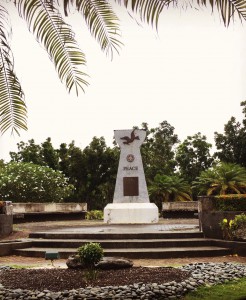AsiaPacificReport.nz
By Sylvia C. Frain in Saipan
Eight groups plan to file a lawsuit against the US Department of the Navy and the US Fish and Wildlife Service for failure to comply with the Endangered Species Act (ESA).
Notice of the lawsuit was received by the US Department of Defense, the US Department of the Interior, the Secretary of the Navy at the Pentagon and the Director of US Fish and Wildlife Service on February 25.
It is expected that the Navy will respond by the end of this month. The ESA requires a 60-day period before litigation can begin – the earliest to file suit is 26 April 2016.

On 1 October 2015, the Fish and Wildlife Service announced 23 new plant and animal species in the Northern Marianas and Guam as threatened or endangered.
Following this declaration, the Navy has failed to comply with ESA Section 7, which requires a reassessment of the Navy’s ongoing Mariana Island Training and Testing (MITT) programme.
The Navy, along with the service, must ensure that any action authorised, funded, or carried out by the Navy such as the MITT program is not likely to jeopardise the continued existence of the newly listed threatened or endangered species (16 U.S. C. § 1536(a)(2)).
The Navy must request from the service whether any listed or proposed species may be present in the area and if so, the Navy must prepare a “biological assessment” to determine if the species may be affected by the proposed action.
Critical habitat
If the action may affect any listed species or critical habitat, the Navy must consult with the service. The Navy has also failed to commit resources to find reasonable and prudent alternatives for training and testing.
Earthjustice attorney David Henkin uses the service’s own words from the final rule extending ESA protection to the Mariana Islands species:
“The MITT area opens up every island within the Mariana Archipelago as a potential training site…which subsequently may result in negative impacts to any number of the 23 species addressed.”
Marianas Island Training and Testing (MITT)
In August 2015, the Navy authorised the expansion of Mariana Island Range Complex (MIRC), a project that earned “A Finding of No Significant Harm” (FONSH) status, according to the Navy’s Environmental Assessment.
The 500,000 sq-nautical-mile training and testing area around the Mariana Islands was doubled and now includes nearly a billion square-miles; an area larger than the states of Washington, Oregon, California, Idaho, Nevada, Arizona, Montana, and New Mexico combined.
This training area also overlaps the area protected by Mariana Trench Marine National Monument, also administrated by the service.

The training and testing within the MITT area includes the use of explosive bombs from the air, sea and land and amphibious, anti-surface, electronic, anti-submarine, and mine warfare. It also includes undersea ordnance training — with a roughly 300 percent increase of bombing on Farallon De Medinilla, or No’os island.
The Navy also approved state-of-the-art high frequency undersea sonar systems to be operated from Navy vessels — similar to that linked to causing death among whales and dolphins.
In March 2015, a federal court ruled that these sonar exercises and underwater detonations in the waters surrounding Hawai‘i and off the coast of California violate the Marine Mammal Protection Act and the Endangered Species Act.
Community Organisations
The ESA process is the only legal framework in which to challenge the Navy’s activities. The Mayor of the Northern Mariana Islands (Gani Islands), Jerome Aldan, supports the potential lawsuit, along with the eight organisations: Alternative Zero Coalition, Center for Biological Diversity, Fanacho Marianas, Guardians of Gani, Oceania Resistance, PåganWatch, Tinian Premier Football Club, and Tinian Women’s Association.
“The American citizens who live here — who have said ‘NO’ in a strong and clear voice—are also being disregarded,” says Peter J. Perez, co-founder of PåganWatch. “A department of the federal government, not the leadership of the United States, not the President and the Congress, but a department, somehow has the right to unilaterally decide to turn a state’s territory into the world’s largest live-fire training range.”
In 2013, the late CNMI governor Eloy Songao Inos requested that the Navy conduct more in-depth assessments of their activities, respect marine protection areas, and refrain from undersea training occurring in areas with high levels of marine life.
The Navy responded in May 2015, stating that they could not impose these “geographic limitations on training and testing activities,” calling it an “impractical burden” to implement and an “unacceptable impact to the effectiveness” of their training.
Pacific Pivot

The potential lawsuit is only a small element of the resistance to the American foreign policy “Pacific Pivot,” that calls for additional militarisation of the region. The Department of Defense has released numerous documents outlining military projects in the Mariana Archipelago.
The largest project, approved in August 2015, includes the relocation of 5000 Marines and their dependents from Okinawa to Guam, the construction of housing containments and a live-fire training range complex adjacent to the only National Wildlife Refuge on the island.
Additional proposed projects include housing artillery, mortar, grenade ranges on the island of Tinian, and to use the entire island of Pågan for bombing and range training purposes.
While the local community continues to show resistance to the militarisation of their sacred and scarce islands, the Navy only emphasises the need for servicemen to train in the land, sea, and air of the Marianas in the name of “national security”.
Sylvia C. Frain is a doctoral candidate with Te Tari Kōrero Nehe me te Mahi Toi Onamata/The Department of History and Art History, Te Ao O Rongomaraeroa/The National Centre for Peace and Conflict Studies, at Te Whare Wānanga/Otāgo University of Otago and a research associate with the Richard Flores Taitano Micronesia Area Research Center (MARC), Unibetsedåt Guåhan University of Guam in the Marianas, Micronesia. She founded Oceania Resistance to share her autoethnographical research relating to decolonisation and demilitarisation efforts across the region.
More information: Chamorro.com
Resisiting the US military in the Marianas
–]]>







